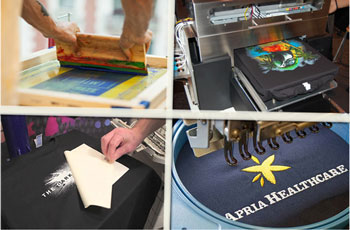
Different people have different preferences when going out to buy a particular product. Herein, production techniques and styles determine the final outlook of the finishing product. It is the same for clothing items including t-shirts.
You may want your t-shirt plain or with print. There are a variety of designs and t shirt printing methods giving an individual characteristic look to each one.
The method to be used is determined by several factors including the design of print, available tools, mass production or not among others.
Top 5 T-shirt Printing Types For Beginners
1. Screen Printing Or Silk Screen Printing
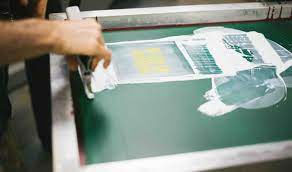
This is probably one of the oldest and most common techniques used to put the print on a t-shirt. The basic principle here is to isolate certain areas within the space you want to print allowing the print ink to flood the rest of the design area and there after creating what we will now call the ‘print’.
The process involves the use of a screen and allowing ink through the same using a tool called a squeegee. A stencil is used to create the design and waterproof material such as rubber or wax is used to keep the ink out of the ‘positive areas’ while letting it into the ‘negative’ areas.
The result is a design by screen printing. You may use a single screen for one color and design or several depending on how complex the design is and how many colors you want to use for the same.
Screen printing is used across the board both for domestic and commercial purposes and can be done manually or by machine and is particularly credited for identical designs.
Read our related article where we compare Vinyl T-Shirt Printing vs Screen Printing. Here’s what you need to know about these processes, including their pros and cons!
Advantages:
- It is a very fast process and can be used to produce many prints in a very short time. This credited to the simplicity of the process. It may only take a relatively longer time to set up the screen. Once that is done the rest is extremely fast.
- Screen printing can be used by armatures that are new to the industry to practice skills. It not a complicated method and be used to inform on the general principles of t-shirt printing.
- The kinds of ink used for screen printing are generally superior in quality compared to other printing methods. This gives them a longer lifespan.
- The method is fabric friendly as it does not expose the material used to harsh conditions that may discolor or damage the fabric. It is also usable on different types of fabric and the only variable here would be to use a suitable type of ink depending on the cloth.
- It is easy to create unique limited designs by destroying the stencil once you are done with the desired number of prints. It is very hard to identically replicate a stencil design and a fake would easily be noticeable to a keen eye.
It may be the oldest printing method used since the 15th Century but it also has its downsides which include:
Disadvantages:
- It is not the neatest printing method given the use of ink and pressing over a screen; it can get messy.
- It controversially been described in some quarters as requiring too much labor and time; this school of thought argues that it takes a long time to create the design on a stencil as opposed to other methods we will discuss later.
- It is only suitable though not limited to relatively simple designs. It would take a lot of time designing various frames go through the whole process for a complex design which for example could be done in minutes using computer graphics.
Despite its limitations screen printing also referred to as Serigraphy remains one of the most common methods used to print designs on t-shirts.
2. Heat press printing method
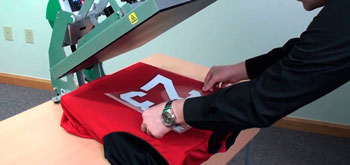
Heat press printing or HPP involves the use of special material called the transfer paper on which a design is printed. The process is actually quite simple; the paper with the design is placed where you want your print. Follow this article to know the details of printing heat transfer paper.
A prescribed amount of heat and pressure is applied on top of the paper causing the dye to transfer onto the fabric when it softens though not into a liquid but more into a kind of thick paste that absorbs into the fabric. The transfer paper is then lifted leaving behind the print.
Advantages:
- The print is relatively durable and looks great on fabrics on the lighter side of the spectrum.
- The technology is easily available and affordable for both domestic and commercial use. It is particularly ideal in this context for large scale production of fabrics including t-shirts.
- There is a variety of transfer papers that allow for both domestic printing using an iron box to mass production using a heat press machine.
- It is definitely not messy given you will not be dealing with liquid ink.
- It does not require a lot of space to do your printing.
Disadvantages:
- The print is visibly very stiff and this in turn gives the fabric the same characteristics.
- The print is not iron friendly and easily gets damaged. This can however be limited by ironing your t-shirt inside out but does not totally eliminate the risk of destroying the print.
- This technique is only suitable for lighter shades of material
This technique is very common for persons producing specific designs for specific purposes in limited quantities.
3. Vinyl cutting
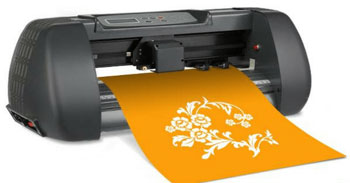
This is an interesting method of putting designs on T-shirts involving the use of a specially designed cloth that is cut into the desired shape and placed onto the t-shirt. This is then pressed using a heat application tool. The heat application component is similar to that of heat press printing. It is preferred because:
- The fact that cloth is used to make the ‘print’ puts it above others in terms of durability; no fading or running of colors.
- It is can create complex designs using multiple layers of fabric using a vinyl cutting machine.
- Different shapes and designs can be made by cutting the fabric into the so desired shape.
It is however limited to only particular letter designs and can be difficult creating certain shapes and designs.
4. Direct to garments or DTG
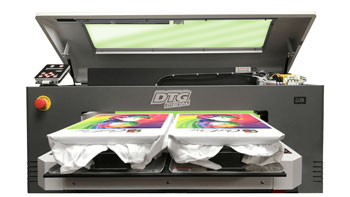
This is a relatively non-labor-intensive process that uses a fabric printer to print a design right from your computer screen. The printer uses special fabric ink and NOT the common paper ink used every day with normal printers.
Advantages:
- It is the easiest way to create the most complex design using a computer graphics application on the computer.
- It is a tidy affair; there is absolutely no handling of the product by hand during the process.
- It is relatively costing less than other automated methods to set up and operate.
Disadvantages:
- There is an under base layer that is applied to dark garments before the design is printed on top. It is sometimes messy and can cause a smudging effect on your t-shirt.
- It cannot be used on fabrics with low cotton content, especially sporting items of clothing.
- It is not as effective printing on dark garments and the print in such cases the print may appear unclear or grainy.
Despite its cons, it is quite popular and is used to make designs in both small- and large-scale quantities.
Read More: What is the Best Type of T-Shirt for Printing? We go over different materials to help you choose the right shirt for your print method!
5. Dye sublimation
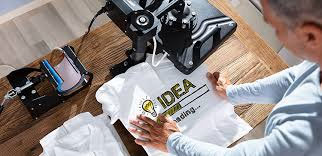
This technique is very different as it uses dye that is transferred onto your t-shirt using a heat application method that converts the state of dye from solid to gas.
It then opens the pores of your fabric and lets in the gaseous form of dye before lowering the temperatures and locking the dye into the fabric. The design is created on a computer screen after which a special dye-sublimation printer is used to complete the process.
It is used by many because:
- The ink and process used does not mess up the fabric by leaks as the dye does not go through the liquid stage. It therefore does not leave any stains behind.
- It has a long-lasting property because the print is not merely laid on top of the fabric but is ‘infused’ into it by the sublimation process.
- You can create complex designs on your computer for this kind of print.
However, it also has its disadvantages including:
- You cannot print clear images; they appear fuzzy and this is because of the whole principle behind the technology; the fusion of ink and cloth causes this effect. An effective print is limited to certain designs.
- You will be limited to a certain size of design and print. The dye sublimation printer cannot do large designs because of its size.
- The process is highly dust sensitive and even a little dust can cause distortion on your design.
These are common methods to use when printing a design on your t-shirt given each one’s pros and cons it is important to research on what method you may want to use which will be influenced by:
- Your level of expertise in a particular field of print.
- Available resources.
- The kind of fabric being used.
- The function of the t-shirt that will be the end product.
- Suited for commercial or small-scale printing.
To this end, it is particularly important to research or consult on the most suitable method. In the absence of this you may end up with a faulty design, damage your fabric or incur an unnecessary financial loss.
Read our related article where we compare Dye Sublimation vs DTG and their uses.
Frequently asked questions (FAQs)
1. What is considered the popular t-shirt printing method?
Inevitably, the popular t printing method should be screen printing. Most of us wear t-shirts that went through this printing process. This method was first invented and introduced in China.
The thought factor behind this was when they were holding a silk mash over a wooden frame, and there were strategically placed holes on the wood, they noticed that those wooden holes left an awesome design on the fabric.
2. Is embroidery considered a printing technique?
Technically, no. There is no printing involved in this one. This method uses a machine to stitch a particular design to your fabric of choice. It can text, image or any other design. Most of the embroidery work you’ll see are on corporate work wear. It has a very professional look and longer-lasting.
The only downside of this method is that it is very hard to replicate intricate designs and small text. Get a quilting machine for sewing and embroidery.
Read More: Best File Format for Shirt Printing. High-resolution files will take your prints to a professional level! We share which file formats are best for printing.
So, What is The Best Types of Shirt Printing?
So, you may want to consider Screen printing for more personal use or if you are operating on a low budget. Most of the requirements are easily improvised.
Heat press printing and vinyl cutting have got similar properties. DTG and dye-sublimation demand more established ventures.
Screen printing sounds more convenient for most of the time. It’s easy and widely popular among t-shirt printers.
In a nutshell, there is no single great method for printing as each process has their own perks and downsides. Choose the one that perfectly suits you rather than the one someone tells you to do.